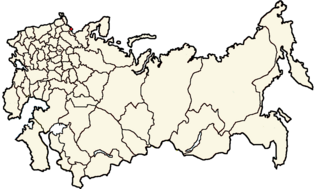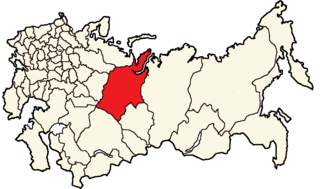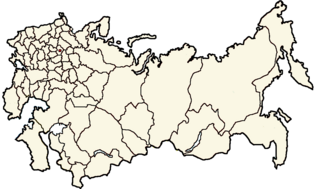Related Research Articles

There are numerous, conflicting accounts on the outcome of the November–December 1917 election to the All-Russian Constituent Assembly. The Constituent Assembly election, which took place in the midst of the First World War and the October Revolution, was the largest exercise of universal suffrage in the history of mankind until that date. Spanning over decades, different historical research projects have been undertaken to try to map the puzzle of outcomes of the election from the various constituencies.

The Petrograd Metropolis electoral district was a constituency created for the 1917 Russian Constituent Assembly election. Petrograd city constituted an electoral district of its own, separate from the rest of the Petrograd Governorate. Voter turnout in the capital was estimated at between 69.7% and 72%.

The Novgorod electoral district was a constituency created for the 1917 Russian Constituent Assembly election. The electoral district covered the Novgorod Governorate. Eight seats in the Constituent Assembly were assigned to the Novgorod constituency.

The Vitebsk electoral district was a constituency created for the 1917 Russian Constituent Assembly election. The electoral district covered the Vitebsk Governorate. White Russian separatism was a negligible force in the electoral district.

The Vladimir electoral district was a constituency created for the 1917 Russian Constituent Assembly election. The electoral district covered the Vladimir Governorate. Vladimir was heavily industrialized, second only to Moscow itself. There were many textile mills in Ivanovo-Voznesensky. Out of 11 lists submitted, 7 were approved whilst 4 non-partisan peasants' lists were denied registration.
The Caucasian Front electoral district was a constituency created for the 1917 Russian Constituent Assembly election. The electoral district covered the Caucasian Front of the Russian Army. Moreover, it included the Urmia-Van Flotilla.
The Romanian Front electoral district was a constituency created for the 1917 Russian Constituent Assembly election. The electoral district covered the Romanian Front of the Russian Army. Moreover, the constituency covered the Danube Flotilla.
The South-Western Front electoral district was a constituency created for the 1917 Russian Constituent Assembly election. The electoral district covered the South-Western Front of the Russian Army.

The Kursk electoral district was a constituency created for the 1917 Russian Constituent Assembly election. The electoral district covered the Kursk Governorate.
The Western Front electoral district was a constituency created for the 1917 Russian Constituent Assembly election. The electoral district covered the Western Front of the Russian Army.
The Baltic Fleet electoral district was a constituency created for the 1917 Russian Constituent Assembly election. The electoral district covered the military forces and employees and workers at bases under the command of the Baltic Fleet. Baltic Fleet used a separate electoral system, where the voter could vote for two individual candidates rather than fixed party lists.
The Northern Front electoral district was a constituency created for the 1917 Russian Constituent Assembly election. The constituency covered the Northern Front of the Russian Army. And apart from the Northern Front itself, the electoral district also included the Russian troops stationed in Finland as well as the Lake Peipus Flotilla. Voter turnout stood at 72.36482% per official records.

The Tobolsk electoral district was a constituency created for the 1917 Russian Constituent Assembly election.

The Taurida electoral district was a constituency created for the 1917 Russian Constituent Assembly election.

The Moscow Metropolis electoral district was a constituency created for the 1917 Russian Constituent Assembly election. The electoral district covered the city of Moscow. Voter turnout in the city was estimated at between 65.4% and 69.7%.

The Tver electoral district was a constituency created for the 1917 Russian Constituent Assembly election.

The Perm electoral district was a constituency created for the 1917 Russian Constituent Assembly election. The electoral district covered the Perm Governorate.

The Oryol electoral district was a constituency created for the 1917 Russian Constituent Assembly election.

The Tambov electoral district was a constituency created for the 1917 Russian Constituent Assembly election.
The Russian Expeditionary Forces in France and the Balkans formed an electoral district for the 1917 Russian Constituent Assembly election. The constituency had some 20,000 eligible voters. The Russian troops in France and the Balkans were supposed to elect one assembly member each by majority vote, and the assembly member would not be replaced in case the seat would become vacant. However, no electoral result was available from the district.
References
- ↑ Олег Иванович Чистяков (1994). Российское законодательство X-XX веков: Законодательство эпохи буржуазно-демократических ревоюций. Юридическая лит-ра. pp. 176–177.
- ↑ Oliver Henry Radkey (1989). Russia goes to the polls: the election to the all-Russian Constituent Assembly, 1917 . Cornell University Press. pp. 148–160. ISBN 978-0-8014-2360-4.
- ↑ Л. М Спирин (1987). Россия 1917 год: из истории борьбы политических партий. Мысль. pp. 273–328.
- ↑ Лев Григорьевич Протасов (2008). Люди Учредительного собрания: портрет в интерьере эпохи. РОССПЭН. ISBN 978-5-8243-0972-0.
